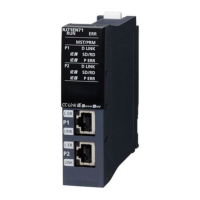16
1 Outline
1.2 Substitute Models
Improved Programming Environment
User-friendly Programming Software (GX Works3)
■System design with a convenient parts library
With GX Works3, designing a system is as easy as preparing the module configuration diagram by dragging and dropping
selected parts.
■Auto-generation of module parameters
When preparing the module configuration diagram, simply double-click the module to automatically generate the module
parameters. A window with an easy-to-use parameter settings screen opens, enabling module parameters to be modified as
needed.
■Main programming languages supported
The main IEC languages are supported by GX Works3. Various different programming languages can be used within the
same project simultaneously, and the labels and devices used in each program can be shared.
1.2 Substitute Models
The recommended substitute models (MELSEC iQ-F Series) introduced in this manual are general substitute models
considered from the number of input/output points, program capacity, product and input/output terminal type (terminal block/
connector etc.). According to usage and service condition, other substitute models different from those described may be
suitable. Also, the recommended substitute models may no longer be appropriate due to factors such as the release of new
products to the market and function improvements.
Please plan replacement to a substitute model with the following procedures.
Procedure to Replace to Substitute Model
1. Investigation of the existing system
List the installed places, number of units, and the type of PLCs. Investigate the programs and wiring diagram etc.
2. Diagnosis of the facilities
Make a diagnosis of the facility’s importance and duration of service, usage environment etc., and set priorities and plan the
replacement procedure.
3. Selection of the models
Select the replacement models according to the number of input/output points and the availability of extension modules etc.
Select from the latest MELSEC iQ-F Series.
4. Reuse of the program
Consider either to reuse the program of the existing system, or create new program.
When reusing, convert and correct the read out program to the new PLC’s format.
5. Replacement of the models
Arrange the selected models and replace on-site.
6. Debug of the system
Test the system after replacement and adjust bugs and timing.
7. Completion
After debugging, migrate to live operation.

